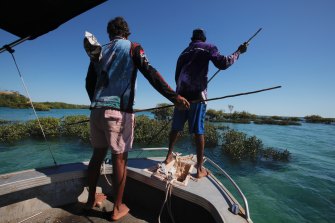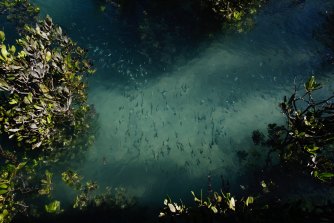In the Kimberley region of Western Australia, mangroves have been a central part of life for many Traditional Owner groups for thousands of years.
The sometimes muddy mazes are a rich source of bait at low tides, with oysters, cockles and crabs.
At high tide they can be a plentiful hunting ground for bigger prey.
Traditional hunting outside Ardyaloon community on Bardi country.Credit:Kimberley Land Council
One particular mangrove species can also be used for making a galwa – a long raft, used to traverse the waterways and meet with other saltwater groups further abroad.
Bardi man Daniel Oades is the Kimberley Land Council’s land and sea unit manager and says the mangroves are a rich environment with high cultural importance.
“There’s so much food and resources, a lot of western scientists, they don’t understand some of the depth of traditional knowledge that’s held within those places,” he said.
“Traditional Owners just want to keep those mangrove areas as healthy as they can be, we’ve seen in the Gulf of Carpentaria there was a massive mangrove die-off.
“We get worried about what happens with too much salt water intrusion or changes to the water table affecting that.
“I think more research is going to identity the value of these systems.”
The Gulf of Carpentaria lies between the Northern Territory and Queensland and saw 7000 hectares of mangroves die-off during a particularly dry El Niño weather period in 2015-16.
Oades is also a co-chair for the Indigenous Saltwater Advisory Group in the Kimberley that directs a lot of the scientific research happening in the region.
He said there was a need for more carbon reserve research and to put more value on recognising the benefit of keeping existing forests in a pristine state.
“People might have to make hard decision without the full information of the benefit of those systems,” Oades said.
“Traditional Owners gain a benefit from keeping country in that pristine state, whereas there could be a potential development come along and we don’t understand the system and how much benefit it is.”
Mangroves like this one in Bardi country in the Kimberley are important nurseries and hunting grounds for different fish species.Credit:Kimberley Land Council
Australian Institute of Marine Science senior research scientist and indigenous partnerships Dr Martial Depczynski has worked with ranger groups in the Kimberley for several years and said collaborations with Traditional Owners had been critical for studies in the region.
“As scientists you go into a new area and you don’t know the lay of the land … when you have 10-metre tides, you have irukandji, crocodiles, sharks, you can’t actually get into the water,” he said.
The Bardi Jawi rangers monitor the mangroves and previous studies have looked at the fish recruitment in marine areas, which are important not just for traditional fishing but also commercial operations.
“Mangroves are pretty important the world over, they form quite complex microhabitats for fish species,” Depczynski said.
“Fish, especially in the tropics, spawn and the larvae go out into the open ocean and they grow a little and then they come back to the reef in a process called recruitment.
“When they come back on to the reef, they’re subjected to incredibly high amounts of predation … so what is important when they come back to recruit from the reef is they find suitable habitat to escape that predation gauntlet.
“We often focus on iconic things like coral reefs, but if we want to maintain biodiversity we need to make sure the diversity of habitats are conserved and looked after and managed properly. Because without that we will lose a component of the biodiversity.”
Follow WAtoday on Instagram, LinkedIn, Facebook and Twitter for handpicked selections of the day’s biggest local, national and international news.
Most Viewed in Environment
From our partners
Source: Read Full Article



